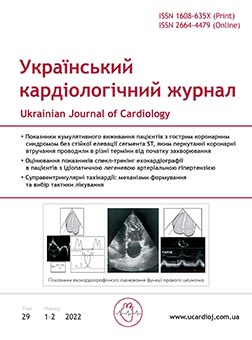Predictors of three-year survival in hospitalized patients with atrial flutter
Main Article Content
Abstract
The aim – to estimate the survival analysis of patients with atrial flutter after index hospitalization during a three-year follow-up and to determine independent predictors of survival.
Materials and methods. The one-center prospective study included 126 patients with various forms of AFL, among them 86 (68.3 %) men and 40 (31.7 %) women, the median age was 65.5 (quartiles 55–73) years. The median follow-up was 26 (quartiles 1–46) months after index hospitalization. Survival analysis was performed by Cox regression for continuous variables, also by estimating Kaplan – Meier curves and by χ2 for ranked variables (with more than 2 ranks) and using Cox’s F-test for binary variables.
Results. During the three-year follow-up period 22 (17.5 %) patients died. The 36-months cumulative survival rate was 80.9 %. In multivariate Cox regression analysis presence of decreased left ventricular ejection fraction, left ventricular wall hypertrophy, previous episodes of AFL, hemodynamic instability during AFL and chronic kidney disease (p<0.05) were significant risk factors associated with mortality.
Conclusion. The cumulative survival rate at 36 months of follow-up was 80.9 %. Independent predictors of poor survival are decreased left ventricular ejection fraction, left ventricular wall hypertrophy, presence of previous episodes of AFL, hemodynamic instability during AFL, chronic kidney disease.
Article Details
Keywords:
References
Granada J, Uribe W, Chyou P, Maassen K, Vierkant R, Smith P, et al. Incidence and predictors of atrial flutter in the general population. J Am Coll Cardiol [Internet]. 2000;36(7):2242–6. doi: https://doi.org/10.1016/S0735-1097(00)00982-7.
Hindricks G, Potpara T, Dagres N, Bax JJ, Boriani G, Dan GA, et al. 2020 ESC Guidelines for the diagnosis and management of atrial fibrillation developed in collaboration with the European Association for Cardio-Thoracic Surgery (EACTS). Eur Heart J. 2021;42(5):373–498. doi: https://doi.org/10.1093/eurheartj/ehaa612.
Glover B, Chen J, Hong K, Boveda S, Baranchuk A, Haugaa KH, et al. Catheter ablation for atrial flutter: a survey by the European Heart Rhythm Association and Canadian Heart Rhythm Society. Europace. 2016;18(12):1880–5. doi: https://doi.org/10.1093/europace/euw402.
Lin Y, Chen Y, Chen T, Lin M, Liu C, Yang T, et al. Comparison of clinical outcomes among patients with atrial fibrillation or atrial flutter stratified by CHA2DS2-VASc Score. JAMA Netw open. 2018;1(4):e180941. doi: https://doi.org/10.1001/jamanetworkopen.2018.0941.
Chen YL, Lin YS, Wang HT, Liu WH, Chen HC, Chen MC. Clinical outcomes of solitary atrial flutter patients using anticoagulation therapy: A national cohort study. Europace. 2019;21(2):313–21. doi: https://doi.org/10.1093/europace/euy181.
Jastrzębski M, Stec J, Fijorek K, Pavlinec C, Czarnecka D. CHADS2 and CHA2DS2-VASc scores as tools for long-term mortality prognosis in patients with typical atrial flutter after catheter ablation. Kardiol Pol. 2020;78(1):59–64. doi: https://doi.org/10.33963/KP.15102.
Lang RM, Badano LP, Mor-Avi V, Afilalo J, Armstrong A, Ernande L, et al. Recommendations for cardiac chamber quantification by echocardiography in adults: An Update from the American Society of Echocardiography and the European Association of Cardiovascular Imaging. Eur Heart J – Cardiovasc Imaging [Internet]. 2015;16(3):233–71. doi: https://doi.org/10.1093/ehjci/jev014.
Vadmann H, Gorst-Rasmussen A, Hjortshøj SP, Riahi S, Lip GYH, Larsen TB. Death and thrombo-embolic risk after ablation of atrial flutter compared with atrial fibrillation: a nationwide cohort study. Europace. 2017;19(5):838–42. doi: https://doi.org/10.1093/europace/euw107. PMID: 27738075.
Brembilla-Perrot B, Girerd N, Sellal Jm, Olivier A, Manenti V, Villemin T, et al. Risk of atrial fibrillation after atrial flutter ablation: impact of AF history, gender, and antiarrhythmic drug medication. J Cardiovasc Electrophysiol [Internet]. 2014;25(8):813–20. doi: https://doi.org/10.1111/jce.12413.
Rahman F, Wang N, Yin X, Ellinor PT, Lubitz SA, LeLorier PA, McManus DD, Sullivan LM, Seshadri S, Vasan RS, Benjamin EJ, Magnani JW. Atrial flutter: Clinical risk factors and adverse outcomes in the Framingham Heart Study. Heart Rhythm. 2016;13(1):139–48. doi: https://doi.org/10.1016/j.hrthm.2015.07.031.

